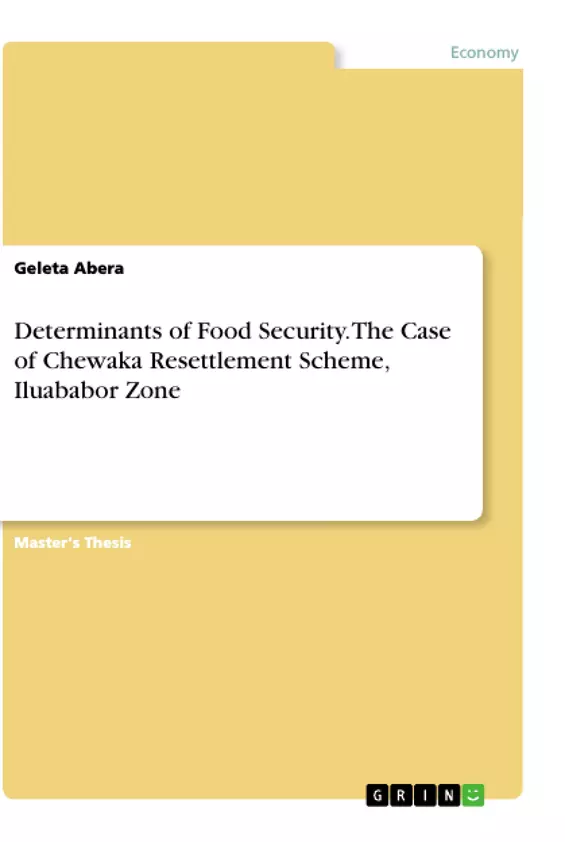This study was undertaken to assess and analyze the impact of resettlement on food security status of resettled households in the study area; assessing the determinants of household food security differentials; assessing the determinants of the program on the food security; and forwarding certain suggestions for ways of improving the program should the need arise. To this end, Descriptive statistics, and binary logic model were used. Both primary and secondary data were also employed in getting the necessary information for the analysis of the study. A total of 92 sample respondents were identified using proportional random sampling technique.
The study gives due attention on empirical assessment of potential research gap of knowing the extent the livelihood strategies attain on food security; reduced poverty and how it is sustainable in ensuring development. To study a specific resettlement program, therefore, provides the opportunity to study aspects of resettlement in relation to people‘s livelihoods and food security in general. Finally evaluating the determinants of resettlement on food security of Chewaka resettlement scheme will serve as a base for future since no studies has been conducted in this area regarding determinants of resettlement on food security.
This study is limited to the determinants of resettlement on food security in Chewaka resettlement scheme on the information that obtained from resettled households of the Woreda in the year 2015/2016. Of the resettlements undertaken in different tabias of Chewaka Woreda, four Villages were selected. In selecting the tabias and resettlement sites, special attention is paid to impact of resettlement on food security and its determinants with respect to general socio-economic conditions at a household level. One of the limitations is the difficulty in getting proper responses from respondents regarding their status of food security because respondents are not willing to give true information on the amount of crop they produce annually. The availability and accuracy data can also affect the study. There are many terms, which involved the respondents estimating quantities. These estimates should be treated as having high error terms.
Inhaltsverzeichnis (Table of Contents)
- CHAPTER ONE.
- 1. INTRODUCTION
- 1.1 Background of the study....
- 1.2 Statement of the problem....
- 1.3 Objectives of the study.
- 1.3.1 General objective............
- 1.3.2 Specific objective.
- 1.4 Hypotheses of the study......
- 1.5. Significance of the study
- 1.6 Scope and limitation of the study.
- CHAPTER TWO....
- CONCEPTUAL FRAMEWORK AND LITERATURE REVIEW.
- 2.1. Concept and definitions..
- 2.1.1. Definition of terms
- 2.1.2 Understanding the concept of Resettlement.
- 2.1.3. The concept of food security
- 2.1.4 Food Security Situation in Ethiopia..
- 2.1.5 Debates on the Effectiveness of Resettlement Program to Food Security Attainment
- 2.2 Empirical Literature reviews
- 2.2.1. Studies on Resettlement
- 2.2.2. Studies on food security.
- CHAPTER THREE………………………………..\nMETHODOLOGY
- 3.1 Description of the Study Area
- 3.2 Data Source and Type
- 3.3 The Sampling Technique and Sample size Determination.
- 3.4 Data Analysis
- 3.5. Variables and analytical methods.
- 3.5.1. Measuring food self-sufficiency and food security.
- 3.5.2. Inferential statistics.........
- 3.5.3 Estimation Procedure...
- 3.6 Definition of Variables and Working Hypotheses
- 3.7 Ethical Clearance....
- RESULTS AND DISCUSSIONS.....
- 4.1 Measuring the Food Security Status of the Resettled Households.
- 4.2 Analysis of socio economic characteristics of the sample resettled households.
- 4.2.1 Age of the resettled Household Head.
- 4.2.2 Educational Status of resettled Households.
- 4.2.3 Family Size and Dependency Ratio.......
- 4.2.4 Summary of Explanatory Variables
- 4.3 Food expenditure and Total expenditure.
- 4.4 Econometric Results.
- 4.4.1 Determinants of Resettlement on Food Security .....
- 4.4.2 Application of logit model to identify factors that determine food security status of resettled households....
Zielsetzung und Themenschwerpunkte (Objectives and Key Themes)
This thesis examines the determinants of food security within the Chewaka Resettlement Scheme in the Iluababor Zone of Ethiopia. The study aims to identify the factors influencing the food security status of resettled households and analyze the effectiveness of the resettlement program in achieving food security goals.
- Impact of Resettlement Programs on Food Security
- Socioeconomic Determinants of Food Security
- Food Expenditure and Consumption Patterns
- Econometric Analysis of Food Security Determinants
- Policy Recommendations for Enhancing Food Security in Resettlement Schemes
Zusammenfassung der Kapitel (Chapter Summaries)
Chapter One provides an introduction to the study, outlining the background, problem statement, objectives, hypotheses, significance, and scope. Chapter Two delves into the conceptual framework and literature review, defining key terms related to resettlement and food security, exploring existing research on resettlement programs and food security, and examining the food security situation in Ethiopia. Chapter Three describes the methodology employed in the study, including the study area, data sources, sampling techniques, data analysis methods, and variables used. Chapter Four presents the results and discussions of the study, analyzing the food security status of the resettled households, exploring socioeconomic characteristics, examining food expenditure patterns, and presenting the econometric results.
Schlüsselwörter (Keywords)
The primary keywords and focus topics of this thesis include food security, resettlement, socioeconomic determinants, Ethiopia, econometric analysis, logit model, food expenditure, and policy recommendations. The study delves into the impact of resettlement programs on food security, examines the relationship between socioeconomic factors and food security status, and utilizes econometric methods to identify key determinants of food security in the Chewaka Resettlement Scheme.
- Quote paper
- Geleta Abera (Author), 2016, Determinants of Food Security. The Case of Chewaka Resettlement Scheme, Iluababor Zone, Munich, GRIN Verlag, https://www.grin.com/document/1001335



